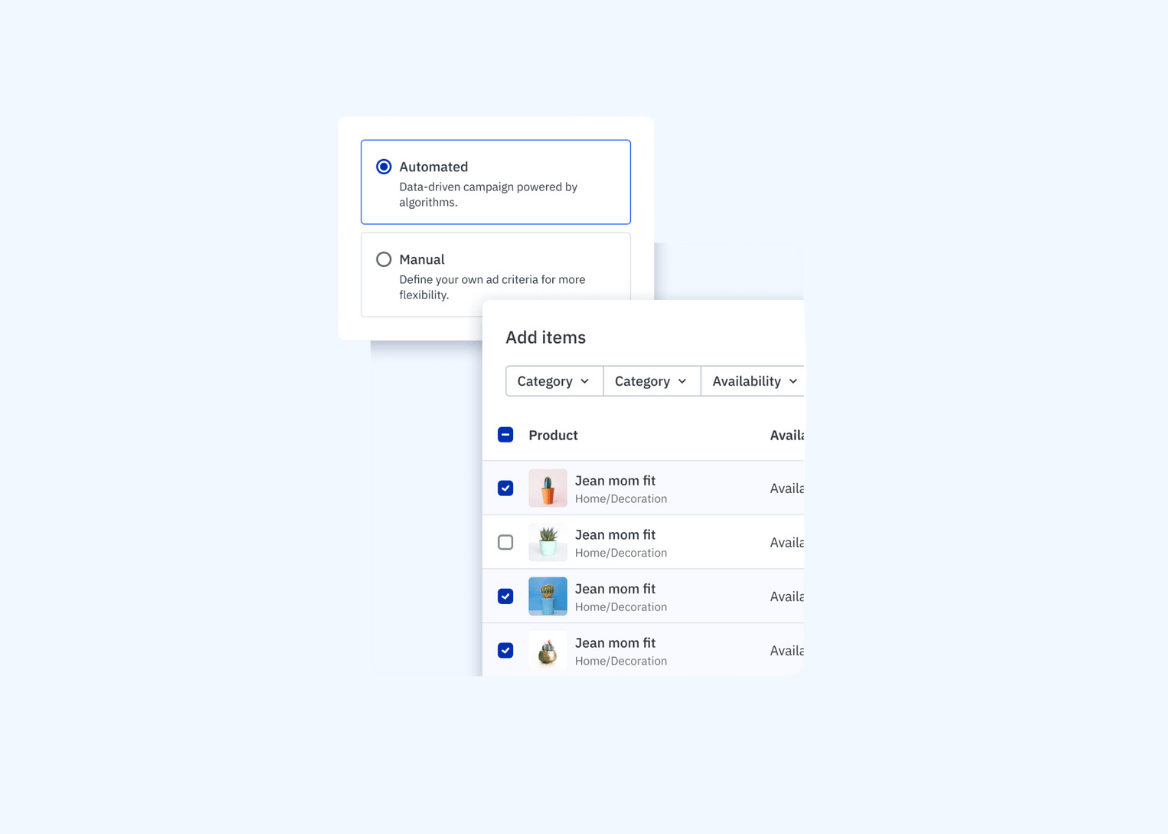How do retail media networks make money?

Retail media has emerged as a powerful revenue generator for retailers.
It allows retailers to monetize their digital assets and first-party data by enabling brands to advertise directly to shoppers at the point of purchase.
In this post, we’ll explore the primary revenue streams and profit opportunities that help RMNs generate revenue making them an attractive strategy for retailers.
Understanding retail media networks and their significance
Retail media networks are advertising platforms that leverage retailers' digital properties and customer data to connect brands with consumers.
Their rapid growth is remarkable — according to BCG, the retail media market is projected to grow by 25% per year to $100 billion by 2026 and will account for over a quarter of all digital media spending.
What makes RMNs particularly attractive to retailers is their impressive profit margins. While traditional retail margins typically hover between 3-4%, retail media advertising can deliver margins up to 70-90%.
This stark difference explains why major retailers are wasting no time building their own networks.
Revenue streams for retail media networks
Retail media networks make money through three primary revenue streams: On-site advertising, off-site advertising and data monetization, and strategic partnership with services.
Retail media network revenue streams: On-site
Loading...
For retailers considering the launch or expansion of a retail media network, on-site advertising represents the main approach to retail media because it is the easiest way to achieve profitability and delivers the highest ROAS for advertisers, making it the revenue stream with the greatest market demand.
By leveraging the high-intent traffic already present on their digital properties, retailers can offer brands unique visibility at critical moments in the shopping journey. This not only drives direct monetization but also deepens relationships with brand partners eager to influence purchase decisions closer to the point of sale.
Beyond the clear financial upside, developing robust on-site advertising solutions positions retailers to collect richer data on shopper behaviors and campaign performance.
This data can fuel more personalized experiences, strengthen loyalty, and unlock further innovation across the RMN ecosystem.
As the landscape grows more competitive, the ability to offer flexible, measurable and high-performing advertising can set leading networks apart — transforming digital real estate into a powerful engine for both revenue and customer engagement. While retail media frequently assists brands in targeting consumers throughout their shopping journey, some retailers treat their websites as simple display ad platforms, similar to any other publisher. In actuality, retail media is usually inherent in supporting brands to engage shoppers.
Retail media network revenue streams: Off-site and data monetization
Loading...
As retail media networks mature, expanding beyond on-site environments becomes one strategy for unlocking new growth and value.
Off-site advertising allows retailers to activate their valuable first-party audience, enabling brands to reach high-intent shoppers across the broader digital ecosystem — not just within the retailer’s own channels. This approach dramatically increases campaign reach - engaging customers wherever they are in their online journey -, creates incremental inventory for advertisers and bring shoppers back to the retailer website.
The growing importance of these channels is reflected in recent forecasts: Off-site retail media is expected to account for 18.7% of US retail media ad spend by 2026.
Beyond advertising, the ability to monetize anonymized shopper data and provide sophisticated analytics solutions gives retailers a new avenue for partnership and differentiation.
By offering brands actionable insights, premium dashboards and closed-loop measurement, retailers can deepen relationships and demonstrate the tangible value of their network. In that regard, retail media networks monetize high value reporting data such as:
CTR, CPC/CPM, daily spend and daily clicks benchmarks
Share of voice, share of impression and share of clicks benchmarks
Brand affinity and customer purchase behavior
A/B test results and incrementality
Retail media network revenue streams: Partnerships and services
Loading...
Retailers seeking to drive incremental value and deepen client relationships are increasingly turning to strategic partnerships and specialized services.
By offering campaign strategy consulting, creative development and expert media planning, retailers can play a more involved role in their clients’ marketing success.
These high-touch services not only unlock new revenue streams but also position the retailer as a trusted advisor, fostering long-term collaboration and greater impact.
Building a profitable retail media network
To build a profitable retail media network (RMN) and successfully generate revenue, retailers require a robust technology infrastructure encompassing a demand-side platform for advertisers, a supply-side platform for inventory management, ad exchange and bid engine capabilities, as well as comprehensive analytics and reporting tools.
Several implementation considerations are crucial, including privacy-compliant data management, seamless integration with existing systems, a scalable architecture to handle growth, and user-friendly interfaces for both retailers and advertisers.
Common challenges and solutions
It’s also important for retailers to consider the common challenges they may face when running a retail media network. Those include:
Challenge 1: Integrating disparate data sources
Solution: Invest in a unified commerce platform that can aggregate data from multiple touchpoints.
Challenge 2: Attracting advertisers
Solution: Clearly communicate unique value propositions and implement easy onboarding processes; Invest in tech that makes it easy to connect with brands that meet your customers’ expectations.
Challenge 3: Proving ROI
Solution: Deploy robust tracking and transparent reporting capabilities so you can properly measure return on ad spend (ROAS) and other important metrics.
The marketplace advantage: Amplifying RMN revenue
Enterprise marketplaces create additional opportunities for RMN revenue by:
Expanding the advertiser base through third-party sellers.
Creating more inventory through increased product categories.
Helping even smaller sellers to get the visibility they need.
According to the Forrester study commissioned by Mirakl, marketplace sellers often invest a larger proportion of their GMV in advertising compared to traditional brands, as they cannot rely on existing brand recognition.
This value prop is a key cog in the retail media flywheel, and creates a distinct advantage for marketplace operators that leads to unparalleled scale and growth.
The future of retail media networks
Retail media networks have a promising outlook fueled by a number of trends, including:
Increasing adoption of self-service advertising platforms.
A growing number of off-site media opportunities extending beyond the retailer's direct properties.
The integration of artificial intelligence to optimize advertising campaigns for better results.
Through proper implementation and a well-defined strategy, retail media networks can evolve into a substantial profit center for the business, while simultaneously enhancing the overall shopping experience.
Download our eCommerce growth guide to learn more about how retail media networks can drive profitability for your business.
Retail media network FAQs
How do retail media networks make money?
Retail media networks (RMNs) generate revenue from three primary sources:
On-site advertising on retailer-owned properties.
Off-site advertising and first-party data monetization.
Strategic partnerships and services (e.g., campaign strategy, creative, media planning).
What’s the difference between on-site and off-site retail media, and which performs best?
On-site retail media runs on the retailer’s own digital properties (search results, category pages, product detail pages). It typically achieves the strongest ROAS and is the easiest path to RMN profitability.
Off-site retail media activates the retailer’s first-party audience across the broader web and social platforms, expanding reach and driving shoppers back to the site. In the US, off-site is expected to account for about 18.7% of retail media ad spend by 2026.
How do RMNs monetize data and measurement?
Beyond ads, RMNs can monetize anonymized shopper data and analytics by providing actionable insights, premium dashboards and closed‑loop measurement. High‑value reporting includes CTR, CPC/CPM, daily spend and clicks, share of voice/impressions/clicks, brand affinity and purchase behavior, plus A/B test results and incrementality.
What technology stack is required to build a profitable RMN?
A robust technology stack includes advertiser-facing tools for creating and managing campaigns and a supply-side layer for inventory management. It also requires an advertising exchange and bidding engine to connect buyers and sellers, along with comprehensive analytics and reporting tools to measure and optimize performance.
How do strategic partnerships and services drive revenue growth for retail media networks?
Retailers can offer campaign strategy consulting, creative development and expert media planning. These high‑touch services unlock new revenue and position the retailer as a trusted advisor, fostering long‑term collaboration and greater impact.



